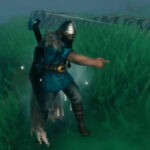Are you looking for a fun and creative dance project? How To Make Dancing Flamingos may be the perfect place to start. At ten-dance.com, we offer everything you need to bring this whimsical vision to life, from in-depth instruction to creative encouragement.
Uncover your inner artisan, discover new dance routines, and join a flourishing community of dance lovers. Start your flamingo dance project now with exclusive courses, community forums, and creative workshops that will inspire your inner dancer.
1. What are Dancing Flamingos and Why Should You Make One?
Dancing flamingos are adorable marionette-style puppets crafted to resemble flamingos in motion. Learning how to make dancing flamingos not only provides a creative outlet but also encourages fine motor skills, imaginative play, and a deeper appreciation for the art of dance. They are delightful, whimsical, and bring smiles to everyone who sees them, making them a great project for both kids and adults.
- Creative Expression: Crafting these puppets lets you explore your creative side, designing and personalizing each flamingo to reflect your unique style.
- Fine Motor Skills: The process of making a dancing flamingo involves intricate steps that help improve dexterity and hand-eye coordination.
- Imaginative Play: Once completed, the puppets provide endless hours of fun, encouraging storytelling, dance performances, and imaginative scenarios.
- Appreciation for Dance: Creating these puppets can inspire a deeper interest in dance, motivating you to explore various dance styles and techniques.
2. What Materials Do You Need To Make A Dancing Flamingo Puppet?
Gathering the right materials is the first step in learning how to make dancing flamingos. Here’s a comprehensive list:
| Material | Description |
|---|---|
| Chunky Yarn | In flamingo pink; the thicker, the better |
| Wooden Beads | 1-inch size, for the feet |
| Thick Yarn | Deep pink or grey, for the legs |
| Ordinary Pink Yarn | For tying the craft together (12 ply or thinner) |
| Clear Jelly Elastic | For marionette strings; can be replaced with white embroidery thread |
| Wooden Chopsticks/Dowel Rods | Disposable wooden chopsticks or similar-sized dowel rods |
| Card Stock | White card stock for printing beak and eye graphics |
| Fabric/Tacky Craft Glue | For adhering small parts |
| Hole Punch | For creating holes in the beak |
| Scissors | For cutting yarn and card stock |
| Recycled Cardboard | Heavy recycled cardboard for pom-pom frames |
| Pom Pom Templates | Free download file |
2.1. Understanding the Importance of Quality Materials
Using high-quality materials ensures the durability and aesthetic appeal of your dancing flamingo. According to a study by the Craft & Hobby Association, crafters who use better materials report higher satisfaction rates and a more professional-looking final product.
2.2. Sourcing Your Materials
You can find these materials at local craft stores like Michaels or Joann Fabrics, or online retailers such as Amazon and Etsy. ten-dance.com also provides links to recommended suppliers, ensuring you get the best products for your project.
3. How To Make The Dancing Flamingo: Step-by-Step Instructions
Follow these detailed instructions to learn how to make dancing flamingos that are both fun and beautiful.
3.1. Creating the Pom-Poms
Pom-poms form the main body parts of your flamingo.
- Prepare Pom-Pom Maker: Trace the pom-pom templates onto heavy recycled card stock and cut out the shapes.
- Wrap with Yarn: Wrap the chunky pink yarn around the frame until you have a puffy, squishy bundle.
- Tie the Center: Use ordinary yarn to tie tightly around the center of the bundle.
- Remove and Trim: Slide the bundle off the frame, tighten the tie, and trim the looped ends.
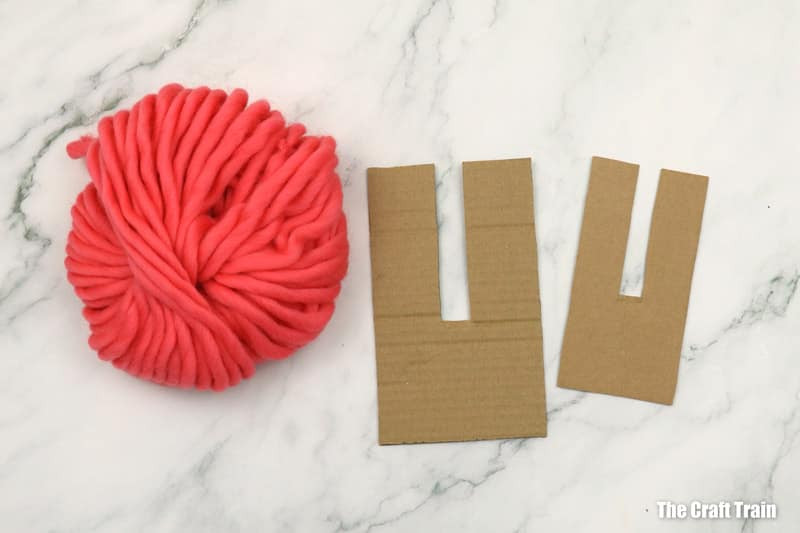 Crafting pom poms for the flamingo body
Crafting pom poms for the flamingo body
3.2. Shaping the Pom-Poms
Trimming the pom-poms gives your flamingo its distinctive shape.
- Trim the Smaller Pom-Pom: Shape the smaller pom-pom into a perfect sphere for the head.
- Shape the Larger Pom-Pom: Trim the larger pom-pom into a teardrop shape with a pointed tail and rounded front for the body.
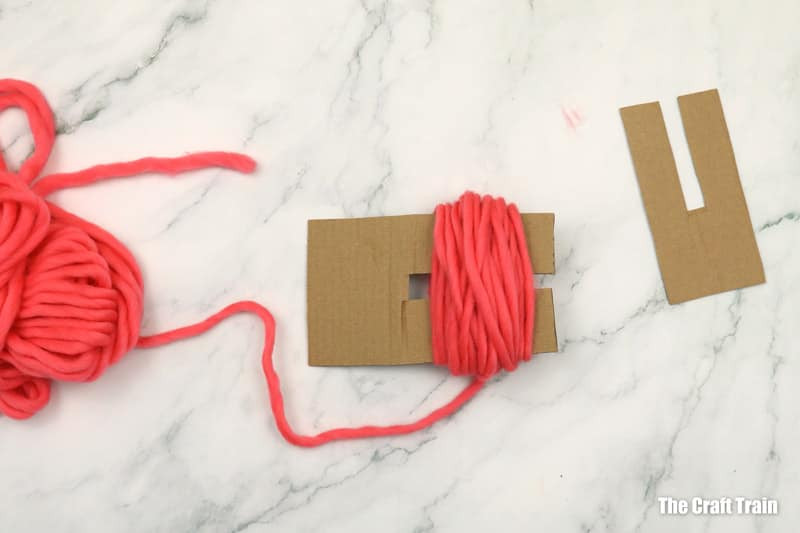 Shaping the pom poms into body parts
Shaping the pom poms into body parts
3.3. Crafting the Neck and Legs
The neck and legs add to the flamingo’s elegant posture.
- Finger Knit the Neck: Use the same chunky yarn to finger knit a neck with two finger loops. Aim for about 20cm/8 inches in length.
- Create the Legs: Use chunky yarn in dark pink or grey for the legs, making them slightly longer than the neck (approximately 28cm/11 inches).
3.4. Assembling the Flamingo Body
Putting the parts together brings your flamingo to life.
- Attach the Neck: Find the center of the pom-poms by separating the fibers. Tie the neck between the body and the head using ordinary yarn.
- Attach the Legs: Tie the legs together at one end and attach them to the underside of the body.
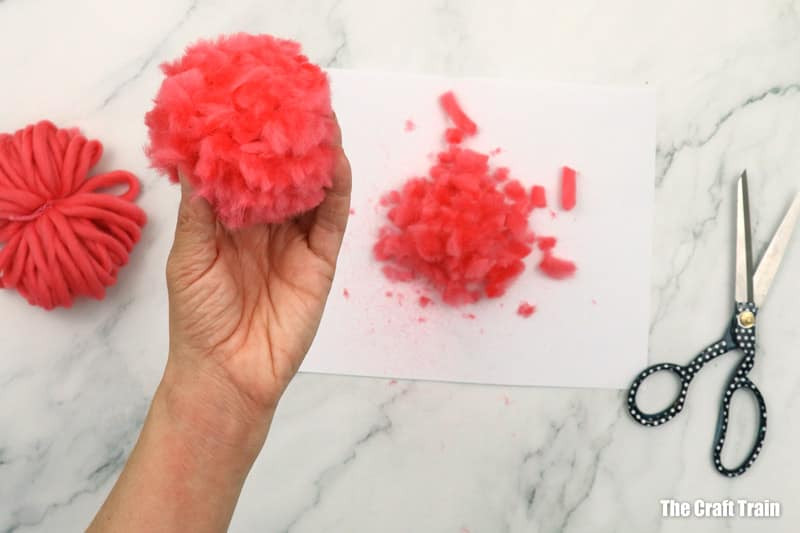 Connecting the neck and legs to the body
Connecting the neck and legs to the body
3.5. Adding the Marionette Strings
These strings will make your flamingo dance.
- Attach Elastic to Body and Head: Cut long lengths of clear jelly elastic and tie one to the body and another to the head. Tie multiple knots to secure.
- Attach Beads to Legs: Tie large wooden beads onto the end of each leg for the feet, using ordinary yarn. Secure with fat knots underneath each bead.
- Attach Elastic to Feet: Tie long strands of jelly elastic to the feet.
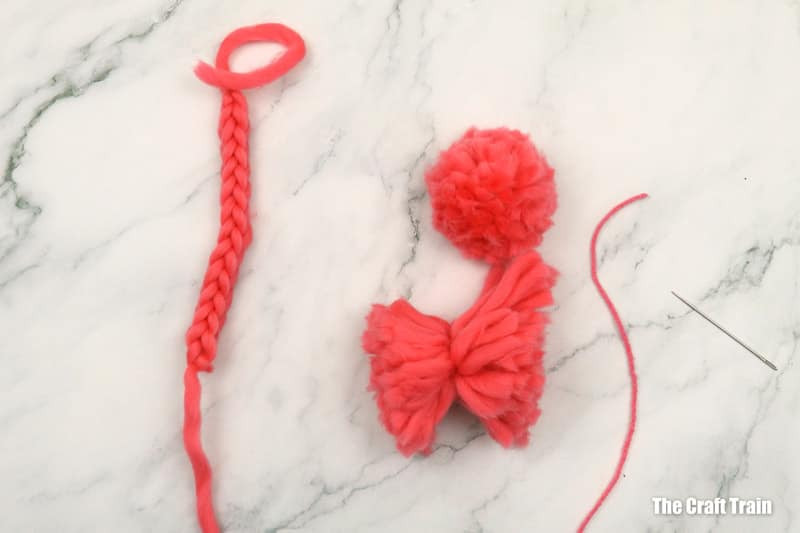 Attaching the marionette strings to the flamingo
Attaching the marionette strings to the flamingo
3.6. Creating the Face
The face gives your flamingo character.
- Prepare the Beak and Eyes: Cut out the rectangular shape around the beak, then glue it together. Cut out the beak and eyes.
- Attach the Beak: Punch a hole in the end of the beak and tie it to the head pom-pom with jelly elastic.
- Glue the Eyes: Glue the eyes onto the head with fabric glue or tacky craft glue.
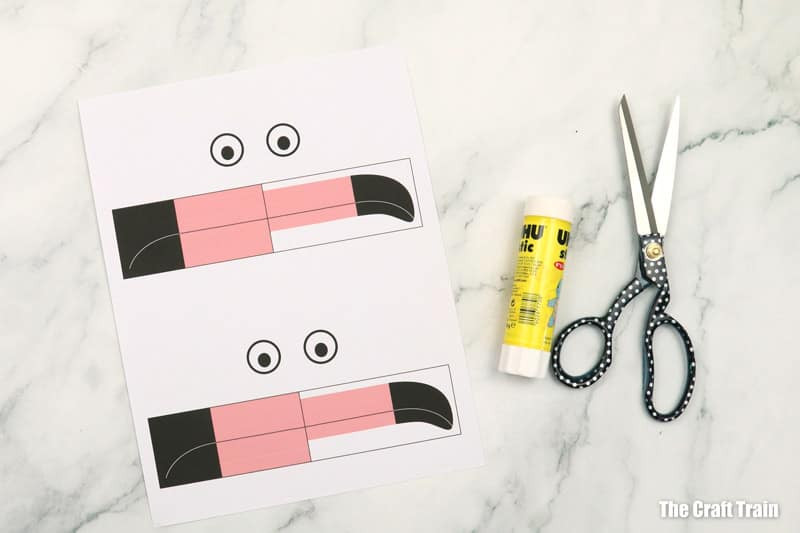 Adding the facial features to the flamingo
Adding the facial features to the flamingo
3.7. Constructing the Control Cross
The control cross allows you to animate your flamingo.
- Create the Cross: Tie the wooden chopsticks into a cross by wrapping yarn around the crossed-over part and tying it tight.
- Attach Marionette Strings: Tie the body shape to the center first, then adjust the leg and head strings to the correct length. Tie a leg string on either side of the body and the head to the front of the cross.
3.8. Final Touches and Making It Dance
Now your flamingo is ready to dance.
- Check All Connections: Ensure all strings are securely tied.
- Practice Dancing: Hold the control cross and gently move it to make your flamingo dance and move.
4. Why Dancing Flamingos are Popular in American Dance Culture
Dancing flamingos, while not a traditional dance form, embody the creativity and whimsy valued in American dance culture. Their appeal lies in:
- Novelty and Uniqueness: They offer a fresh, fun twist on traditional dance, appealing to those looking for something different.
- Educational Value: They introduce basic puppetry and movement concepts, beneficial for beginners and children.
- Community Engagement: They can be incorporated into community arts projects, fostering collaboration and creative expression.
4.1. The Role of Puppetry in Dance
Puppetry has a long history in dance, often used to convey stories or emotions in a unique way. According to the American Dance Therapy Association, incorporating puppetry into dance therapy can enhance self-expression and emotional processing.
4.2. Integrating Dancing Flamingos into Dance Education
Dance educators can use dancing flamingos to teach fundamental dance concepts like rhythm, coordination, and storytelling through movement.
5. How to Customize Your Dancing Flamingo
Personalizing your dancing flamingo is part of the fun. Consider these customization options:
- Color Variations: Use different yarn colors to create unique flamingo designs.
- Accessorizing: Add small accessories like hats, scarves, or bows to give your flamingo personality.
- Bead Variations: Experiment with different bead sizes, shapes, and colors for the feet.
- Embroidery: Embroider details onto the body or neck for added texture and visual appeal.
- Feathers: Glue small feathers onto the body to enhance the flamingo’s appearance.
5.1. Making It Your Own
Customization allows you to express your individuality and create a flamingo that is truly one-of-a-kind.
5.2. Incorporating Cultural Elements
Integrate cultural elements from various dance styles, such as adding a small tutu for ballet-inspired flamingos or a miniature sombrero for a flamenco flair.
6. Where Can You Showcase Your Dancing Flamingo?
Once you’ve learned how to make dancing flamingos, show it off. Here are some ideas:
- Home Decor: Display your flamingo as a unique piece of home decor.
- Gifts: Give your handmade flamingo as a thoughtful, personalized gift.
- Local Craft Fairs: Sell your creations at local craft fairs and markets.
- Dance Performances: Incorporate your flamingo into dance performances or puppet shows.
- Online Platforms: Share your creations on social media platforms like Instagram and Pinterest to inspire others.
6.1. Creating a Portfolio
Document your creations and build an online portfolio to showcase your skills and attract potential buyers or collaborators.
6.2. Participating in Community Events
Join local craft groups or dance communities to share your work and connect with like-minded individuals.
7. What Dance Styles Can You Recreate with a Dancing Flamingo?
Dancing flamingos can be adapted to represent various dance styles, adding a whimsical touch to traditional movements. Here are a few examples:
- Ballet: Create delicate, graceful movements mimicking ballet dancers.
- Flamenco: Incorporate rhythmic clapping and dramatic poses inspired by flamenco.
- Hip-Hop: Design energetic, urban-inspired movements for a contemporary twist.
- Salsa: Emulate the vibrant, fast-paced steps of salsa dancing.
- Modern Dance: Explore expressive, abstract movements reflecting modern dance techniques.
7.1. Enhancing Creativity
Experimenting with different dance styles encourages creativity and helps you develop a deeper understanding of movement and expression.
7.2. Showcasing Versatility
Demonstrate the versatility of your dancing flamingo by creating performances that blend various dance styles.
8. What Are the Benefits of Dance and Creative Expression?
Engaging in dance and creative expression offers numerous benefits for both physical and mental well-being. These include:
- Physical Fitness: Dance improves cardiovascular health, strength, and flexibility.
- Stress Reduction: Creative activities like crafting and dancing can reduce stress and promote relaxation.
- Emotional Expression: Dance provides an outlet for expressing emotions and feelings.
- Cognitive Function: Learning new dance steps and crafting techniques enhances cognitive function and memory.
- Social Interaction: Participating in dance classes or craft groups fosters social interaction and a sense of community.
According to a study by the National Endowment for the Arts, involvement in the arts is associated with improved academic performance and civic engagement.
8.1. Dance Therapy
Dance therapy is a recognized form of therapy that uses movement to promote emotional, social, cognitive, and physical integration.
8.2. Creative Arts Therapy
Creative arts therapy encompasses various artistic modalities, including dance, music, art, and drama, to address mental, emotional, and physical health issues.
9. How Can ten-dance.com Help You Further Your Dancing Journey?
Ten-dance.com offers a wealth of resources to support your dancing journey, from learning how to make dancing flamingos to exploring various dance styles and techniques. Our platform provides:
- Online Tutorials: Step-by-step video tutorials for creating dancing flamingos and learning different dance styles.
- Expert Advice: Tips and guidance from experienced dancers and crafters.
- Community Forums: A supportive community where you can share your creations, ask questions, and connect with other dance enthusiasts.
- Exclusive Courses: In-depth courses on various dance styles, taught by professional instructors.
- Event Listings: Information on local dance events, workshops, and performances.
9.1. Joining Our Community
Become a member of ten-dance.com and gain access to exclusive content, member discounts, and a vibrant community of dance lovers.
9.2. Utilizing Our Resources
Take advantage of our extensive library of articles, tutorials, and resources to enhance your skills and knowledge.
10. Frequently Asked Questions About Making Dancing Flamingos
10.1. What type of yarn is best for making a dancing flamingo?
Chunky yarn in flamingo pink is ideal, as it creates a fluffy and visually appealing puppet. The thicker the yarn, the better your puppet will look.
10.2. Can I use regular yarn instead of chunky yarn?
Yes, you can use ordinary yarn, but the puppet may not look as fluffy. It’s recommended to use at least 12-ply yarn for better results.
10.3. Where can I find wooden beads for the feet?
Wooden beads can be found at local craft stores or online retailers like Amazon and Etsy. One-inch beads are a good size for the feet.
10.4. What can I use instead of clear jelly elastic for the marionette strings?
White embroidery thread can be used as a substitute for clear jelly elastic.
10.5. How do I make the pom-poms?
You can make pom-poms using a DIY cardboard pom-pom maker or purchase a commercial pom-pom maker. Wrap yarn around the maker, tie it in the center, and trim the looped ends.
10.6. How do I shape the pom-poms?
Trim the smaller pom-pom into a sphere for the head. Shape the larger pom-pom into a teardrop shape with a pointed tail and rounded front for the body.
10.7. How long should the neck and legs be?
The neck should be about 20cm/8 inches long, and the legs should be slightly longer at approximately 28cm/11 inches.
10.8. How do I attach the marionette strings?
Tie lengths of clear jelly elastic to the body, head, and feet. Then, attach these strings to a wooden control cross.
10.9. Can I customize my dancing flamingo?
Yes, you can customize your dancing flamingo by using different yarn colors, adding accessories, and experimenting with various dance styles.
10.10. Where can I showcase my dancing flamingo?
You can showcase your dancing flamingo as home decor, give it as a gift, sell it at craft fairs, or incorporate it into dance performances and share on social media.
Conclusion
Learning how to make dancing flamingos is a fulfilling process that combines creativity, dance, and craftsmanship. Whether you’re a seasoned dancer or a beginner crafter, this project offers a unique way to express yourself and create something truly special.
Visit ten-dance.com to discover more dance tutorials, connect with a vibrant community, and unleash your inner dancer. Start your dancing flamingo adventure today and experience the joy of movement and creativity!
Address: 60 Lincoln Center Plaza, New York, NY 10023, United States. Phone: +1 (212) 769-7000. Website: ten-dance.com.

